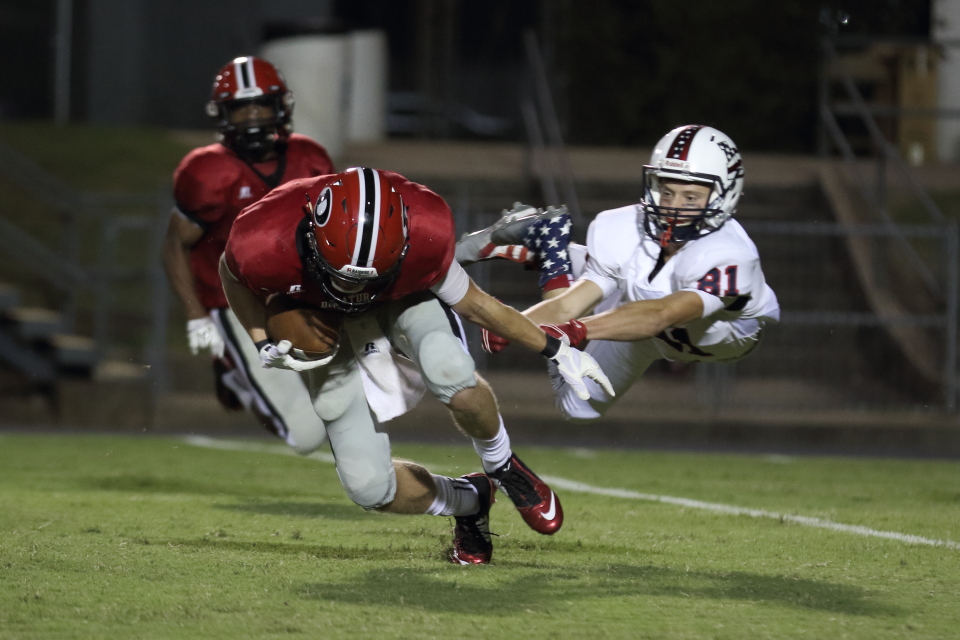I get pretty good results with an APS-C Canon EOS 7D Mark II inside high school gyms and on high school football fields at night. I own two FF cameras as well and use them for wider angle lenses, yet my choice for the 70-200/2.8 is almost always the 7D2.

Canon EOS 7D Mark II + EF 70-200mm f/2.8 L IS II, 200mm, ISO 3200, f/2.8, 1/800. This was one of the most poorly lit fields I have shot at in a while. It took a lot of massaging the color and noise of the raw files in post to get this (and the other shots I took) looking like this.

Canon EOS 7D Mark II + EF 70-200mm f/2.8 L IS II. 185mm, ISO 2500, f/2.8, 1/640. Slightly slower Tv than I normally use because the light dims a bit down near the goal lines where this interception was made.
 EOS 50D + EF 70-200mm f/2.8 L IS II. 120mm, ISO 800, f/2.8, 1/200 second. I shot this one back around 2010 with an EOS 50D. Yeah, it was back when I was saturating colors a bit more than I do now. The lower shutter speed was intentional to get just a bit of blur from the movement of the flag and hands while freezing the face.
EOS 50D + EF 70-200mm f/2.8 L IS II. 120mm, ISO 800, f/2.8, 1/200 second. I shot this one back around 2010 with an EOS 50D. Yeah, it was back when I was saturating colors a bit more than I do now. The lower shutter speed was intentional to get just a bit of blur from the movement of the flag and hands while freezing the face.

Canon EOS 7D + EF 70-200mm f/2.8 L IS II, ISO 1600, f/2.8, 1/200 sec. This one was shot in a high school gym with the notoriously noisy original 7D at a Winter Guard competition. Again, the slower (1/200) Tv was intentional.
Going full frame to shoot football only really makes sense if you are also committed to getting lenses to give back the reach you give up when going from an APS-C format to a larger full frame camera. To get the same reach with a FF camera as your 70-200mm gives you at 200mm, you'll need 320mm. Have you looked at what a 300mm f/2.8 lens costs? If you put the 70-200mm on the FF body and then crop to make up the difference in reach, it's no different than using a crop body to begin with, assuming both have the same generation of technology in their sensors.
Do you notice anything about the gear used to shoot the four example shots above taken over the course of almost a decade?
Three different camera bodies.
- 50D in August, 2010.
- 7D in February 2013.
- 7D Mark II in August 2015
- 7D Mark II in November 2018.
The same exact lens.
- EF 70-200mm f/2.8 L IS II in August 2010.
- EF 70-200mm f/2.8 L IS II in February 2013.
- EF 70-200mm f/2.8 L IS II in August 2015.
- EF 70-200mm f/2.8 L IS II in November 2018.
When shooting sports in low light, it's always more about the lens than the camera. Get the fastest lens you can afford before you start worrying about changing bodies.
For night field sports under lights, it's hard to beat a 70-200/2.8 without accepting a slower aperture or spending a boatload of money. The next step up with f/2.8 is the Sigma 120-300mm f/2.8 Sport for around $3,500. After that, it's all above $5 grand.
With wrestling, if you have access to the floor during matches, fast prime lenses make a lot more sense. For Canon these would include:
- EF 135mm f/2 L
- EF 100mm f/2
- EF 85mm f/1.8
Before you go out and spend a lot of money, make sure your shooting technique and processing workflow aren't contributing more to your issues than sensor performance.
Here are a few other questions here that you might find helpful. They're grouped by those related to technique and processing and those related to gear:
Lots of noise in my hockey pictures. What am I doing wrong?
Is it really better to shoot at full-stop ISOs?
Is this amount of noise expected, or am I doing it wrong?
How to improve image sharpness on Canon 700D?
How to get exposure right in night photography?
How to photograph low light indoor sport?
Recommended shutter speed for action sports?
When should I upgrade my camera body?
Should I upgrade my body or lens first?
Does the camera matter?
Is a 70-200mm f/2.8 without IS suitable for high school sports under artificial lights?
Which Canon lens would be better to capture high school wrestling, 55-250 STM or 70-300 IS II USM?
Are there any cheap, fast lenses capable of highschool sports photography?
Upgrade path for indoor sports photography from 7D + Samyang 85mm f/1.4 MF lens
What Canon lens would be good for shooting high school/college sports?





